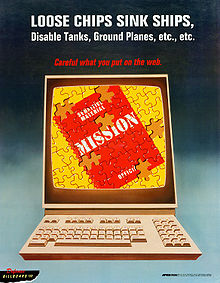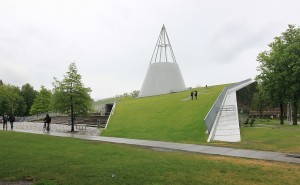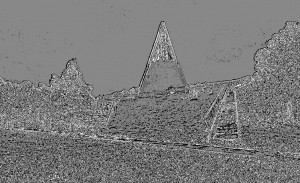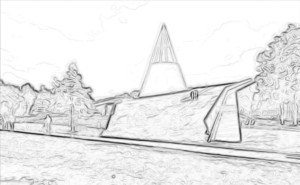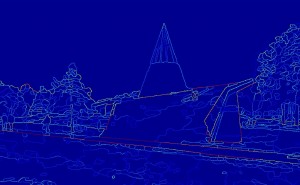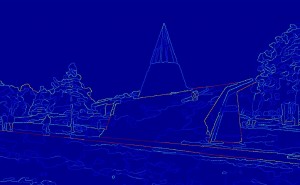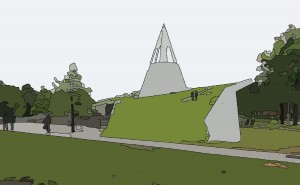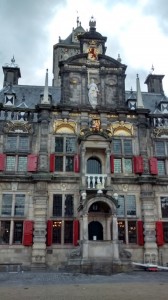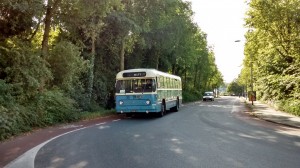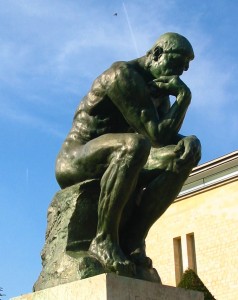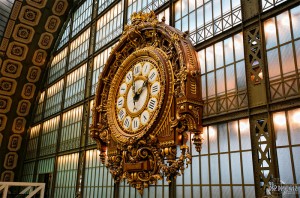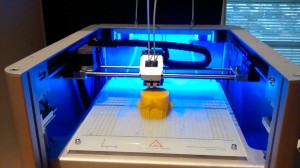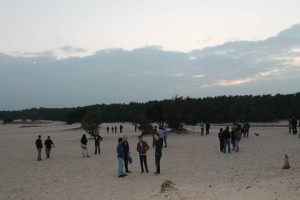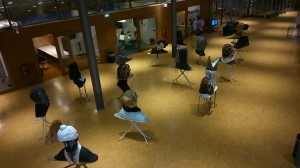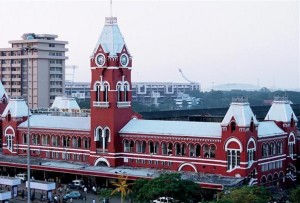Kris Shrishak
Join the dance
“The only way to make sense out of change is to plunge into it, move with it, and join the dance.”
― Alan W. Watts
In March, I had the opportunity to visit the theater in Delft (Theatre de Veste). I watched the three dance routines choreographed by David Middendorp. All of them had an element of technology attached to them.
The first routine was ‘Three Rooms’ and was my favourite. In this routine, two dancers were involved and one could see them being pulled and pushed by elements from outside the room in view. The dancers first oppose, then surrender and finally get carried away by the external elements. This was an abstract routine and left the interpretation to the observer. The first stage of opposition gave an illusion of three rooms being involved. One room that was depicted on stage. The other two on the two sides of the stage from whose inhabitants or other elements prevented the dancers from entering. As the routine progressed, and the reaction of the dancers to the push and pull changed, one realises that there is just one room. It is the mind of the observer that creates the illusion. One might wonder what element of technology was used here. The choreographer, David, was a dancer but he doesn’t dance anymore. So he choreographs by using a mobile app and drawing lines and curves on it which act as a cue for the performers.
The second routine was ‘A dark Flirt with Gravity’ in which the dancers interact with the drones during the performance. The idea is to depict the co-existence of technology and humans and depict the positive and negative effects of technology on the society. The third routine was ‘Blue Journey’ which depicts a struggle of a girl with herself and with the world. She has a blue shadow and realizes that she is different from others around her. We see how she and the society deal with her shadow.
Privacy and security
“Privacy and security are those things you give up when you show the world what makes you extraordinary.”
-Margaret Cho
Quarter 3 has been filled with courses that have assignments and projects. I have opted for five courses which are from diverse fields. Couple of them are from the signal processing field and couple of them are security related while the last one is Medical Imaging.
Estimation and Detection course is compulsory for students of Signals and Systems track. In this course the theoretical background for estimation was dealt in detail while we also had few lectures on detection. The theory is widely used in many present day applications such as radar, sonar, speech enhancement, communication systems, etc. This course is useful for students who are interested in taking Signal Processing for communication course in Q4. Distributed Signal processing course included few concepts in convex optimization as well as graphical models. Both these topics were dealt with keeping Distributed systems in mind.
Network Security and Hacking Lab are the most interesting courses for me this quarter. In Network Security course, vulnerabilities at each of the OSI layers was discussed along with possible countermeasures. The homeworks included implementation of known attacks at the Data Link and Network layer. Though the homeworks were time consuming, it helped in understanding the security requirements of the network stack better.
Medical Imaging course offered by EWI includes Computer Tomography (CT), Magnetic Resonance Imaging (MRI) and Acoustic Imaging. The lectures included a brief overview of the concepts in of these topics. The course grade depends on different assignments for each of these topics. The assignments include a CT image simulation using Matlab, a review on a paper on MRI and a design project for Acoustic Imaging.
In February, Vox Delft screened the movie ‘My Dinner with Andre’. The movie is philosophical and involved two characters who are involved in an extended conversation about life. In addition, Vox Delft also had discussions on couple of interesting topics such as ‘What is there was no such thing as reality?’ and ‘What are the biggest dividing forces in the world?’ I volunteered for TedXDelft which was organized on February 27th. I had the opportunity to have engaging conversations with speakers as well as guests.
Image Source : http://en.wikipedia.org/wiki/Security_awareness#/media/File:Loose_Chips_Sink_Ships.jpg
Information is the oxygen of the modern age…
“Information is the oxygen of the modern age. It seeps through the walls topped by barbed wire, it wafts across the electrified borders.”
— Ronald Reagan
After quarter 2 exams concluded in the last week of January, there were no lectures for a week. There was snow in the weekend after the exams followed by the sun shining brightly for a couple of days. The week off gave me time to read few interesting articles. In this blogpost I will mention few interesting activities that I was involved in during the exam weeks and the week after.
On the afternoon of January 26, Delft Data Science (DDS) New Year event was organized. The event included presentations, masterclasses, posters as well as an interactive panel discussion. The initial presentation gave a brief overview of the “Foundation of Data Analytics and Cyber Security” in TU Delft. Two research directions – Cyber Security through Big Data and Securing Big Data- were addressed briefly. Then the following three masterclasses were conducted:
1. Security and Privacy: Conflict or Harmony
2. Why have a lock at all? On the fallacy of ICT Security
3. Botnets: The Challenge of Bot Detection
As the masterclasses were conducted parallelly, one could attend only one of them. More details on the Masterclasses can be found here. The masterclasses were followed by a lecture on “Anonymizing Darknets”. The lecture was given by Martijn Spitters from TNO and he gave a brief overview of the kind of activities for which darknets are predominantly used. The next lecture was given by Gerald Friedland on “Content-based Privacy for Consumer Produced Multimedia.” You can watch his lecture on collegerama. The event was concluded by an interactive panel discussion wherein few specific questions were discussed.
The video below was part of Gerald Friedland’s talk and certainly requires you to watch.
On January 27, VOX had a discussion on the topic “Can we get over Territorialism” and on February 3, “What if there is no reality” was discussed. You can find out more about VOX here.
A project is complete when it starts working for you
“A project is complete when it starts working for you, rather than you working for it.”
-Scott Allen
January has been a month with extensive activities outside the lecture halls. I had couple of lectures in the first week of January after the Christmas break. After that I wrapped up the course projects for Q2 before heading into the exams.
For the handwritten Digit Classification project for Pattern recognition, we had to edit the report as we had completed the implementation in December. On the other hand, we began the assignment for Filtering and System Identification course in the second week of January and had to do a quick work as we did not have much time. We analysed the given data input and outputs, pre-processed it and eliminated datasets that we thought were not appropriately recorded (in terms of the duration of recording, sampling frequency and the amount of noise). We then used Past Output Multivariable Output Error State Space algorithm (PO-MOESP) to find the system matrices as well as validated our choice through Variance Accounted For (VAF).
The project that took up maximum time was the Image Segmentation project. It has certainly widened my knowledge in the field and it was an enriching experience. The project was an implementation of http://www.cs.berkeley.edu/~malik/papers/arbelaezMFM-pami2010.pdf. We performed contour detection using Local Cues such as brightness, colour and texture by splitting the image into four channels. We made use of Oriented Gradients in each of the channels in eight orientations [0,pi) before choosing the maximum value over the orientations for all channels for each pixel. In the texture channel, k-means clustering was used in order to obtain the textons. In order to include global information, we performed Spectral Clustering. As we did not have closed contours at all times, we performed Hierarchical Segmentation, wherein Watershed Segmentation was extended to Oriented Watershed Transform. Finally we used Ultrametric Contour Mapping. The images from different steps can be seen below.
Original Image
Texture image
Multiscale Oriented Gradients (using the max value over the orientations)
After Watershed Transform
After Oriented watershed Transform (weak boundaries are eliminated)
(click and enlarge the two watershed images to see the difference)
Final image after segmentation
A walk about Paris…
“A walk about Paris will provide lessons in history, beauty, and in the point of Life.”
-Thomas Jefferson
During my initial days in Delft, I decided to explore the city and trace its history. I found that on the second weekend of September every year, most tourist places in the Netherlands are open for free. This is called Monumentendag and this year it was on 13th and 14th September.
During Monumentendag, I visited all the places (except Museum Princenhof and Vanmeer Museum) that I could think of. I took a boat ride on the canals of Delft, visited Molen de Roos and also got a chance to go inside Stadhuis (City Hall). The most treasured visit was to a house where paintings made 500 years ago (estimated) on the ceiling were discovered recently. The weekend was wrapped up by a ride on an old bus which used to ply on the roads more than 30 years ago. I had visited Museum Princenhof in August and felt it is a wonderful museum. The story of Willem Orange was presented in chronological order in a very interactive manner.
In early November, after my quarter 1 exams, I had one week before quarter 2 began. I visited a friend of mine in Paris. I stayed 3 days at his place and went around Paris. Though Tour Eiffel and Musee Louvre are the most famous places in Paris, Musee Rodin and Musee d’Orsay stood out for me. The works of August Rodin, especially the Gate of Hell and the Thinker (which is a part of the Gate of Hell), are marvelous. One could observe them for hours and still miss out on details. Van Gogh’s Starry Night over the Rhone was the highlight of the visit to Musee d’Orsay. The manner in which Van Gogh captured the colours of the night is amazing.
Musee Curie was a small and informative museum about the Curie family and their works. Notre Dame Cathedral with its impressive yet asymmetric architecture was worth a visit. I wrapped my Paris trip with a sumptuous French dinner. I must say that the best thing about Paris is that all places of interest can be visited by foot. The beauty of the city lies in observing the small things that remind you of the good and the bad of the past. Not many talk about the Algiers memorial which is very close to the Tour Eiffel. It is not by accident that there are no modern skyscrapers within the city limits of Paris. Finally a visit to Paris cannot end without a mention of Art Nouveau architecture.
Fallen leaves lying on the grass…
“Fallen leaves lying on the grass in the November sun bring more happiness than the daffodils”
– Cyril Connolly
In November, quarter 2 began and I enrolled in two courses in addition to the two (Pattern Recognition and Seminar Advanced Digital Image Processing) that I am continuing. The first is Filtering and system Identification. This course is compulsory for me as well as many tracks in the Mechanical department. The second is Information Theory. Information theory is such a vast area of study and there are still many concepts which are hard to understand.
Filtering and Identification course is the largest course (in terms of the number of students enrolled) that I have taken. During the initial lectures, there were more than 150 students (rough estimate) attending the lectures. This was also the first course I attended that had its lecture videos recorded and made available on collegerama. This is probably the reason that as we entered into December the population shrunk to one-third. The course structure certainly is interesting and engaging. The final grade is split up into different tasks. 6% of the grade depends on the 4 homework assignments, 4% on the 2 Matlab exercises, 20% on the project and 70% on the written exam (open book). With 6 ECTS, this course certainly requires a lot of time on my part to understand the concepts well.
Information Theory course is theoretical (as the name says) and most of the concepts cannot be applied to real life situation without alteration. It is a 4 ECTS course and students are allowed to carry a double-sided A4 sheet with formulas to the exam. In the Pattern Recognition course, we began our handwritten digits recognition project in which we made an educated guess of selecting 13 classifiers and testing them for the conditions given before deciding on one classifier which satisfied the requirements of the project. In the Image processing course, I was given Image Segmentation project which requires me to implement a segmentation algorithm based on the paper http://www.cs.berkeley.edu/~malik/papers/arbelaezMFM-pami2010.pdf.
3D-Print Expo is taking place in the hall of the library from November 24 till January 19. The exhibition was created for the 3D print week which lasted till November 28. You can find photos in the following link. https://www.flickr.com/photos/tudelftlibrary/sets/72157649055609748/
Life is one big transition
“Life is one big transition.”
-Willie Stargell
When I arrived in the Netherlands, there were few new experiences that I was expecting. But, knowing is different from the true experience. First up is the weather. The transition from a place where the temperature hardly ever drops below 25°C to a place where the temperature hardly ever goes as high as the same temperature was seamless. I do need to wear an extra layer of clothing though.
The University gave the international students a warm welcome in the Introduction week where many intercultural activities were planned. I must admit that it was an enriching experience to know people from different parts of the world. I would have preferred if the Dutch students were also part of the Introduction week. The introduction week was followed by the Master kick-off to Soest organized by the faculty of EEMCS. The three-day programme was filled with introduction lectures and other interactive activities. For me the visit to Soestduinen was the highlight.
The beginning of lectures in Quarter 1 was my first experience in a Quarter system. My undergraduate programme had a Semester system, so this was a new experience. I enrolled in two compulsory (Statistical Digital Signal Processing and Pattern Recognition) and two specialization (Security and Cryptography and Seminar Advanced Image Processing) courses. Statistical Signal Processing course was intense and required regular study on my part to understand the topics covered. Pattern Recognition course is spread over two quarters and has a laboratory session which accompanies the two-hour lecture session. At the end of the course we will do a project on handwritten number recognition. Advanced Digital Image Processing is also spread over two quarters. The first quarter introduced many Image Processing techniques and in the second quarter we need do a project wherein we implement one of the techniques. Security and Cryptography was the most interesting course of the quarter. It initially covered the basic Cryptography topics and mechanisms before introducing advanced topics and present day applications.
The most important aspect of my learning curve has been the manner in which the Professors present themselves and the lack-of-ego in their behaviour. They value theirs as well as the students’ time. This is best exemplified by a story that a friend of mine, who is currently doing his PhD here, told me. When he was working on his Master thesis in his home country, his supervisor would command him to meet him at moment’s notice, even if he was in a different city, miles away. As a punishment, he will be humiliated by the Professor in front of his colleagues. On the contrary, his PhD supervisor sends him an email asking him what time will be convenient for him to meet.
When I arrived in August, the library had a sculpture exhibition of Eveline van Duyl’s work ‘Islands of thought’. From late September till early November, TE[CH]X(T)ILES exhibition was on in the library. These exhibitions, especially the TE[CH]X(T)ILES exhibition, give me an opportunity to think about new things which I might have done otherwise. Apart from the exhibitions, library is also the place where I join VOX discussions every Monday night. We have weekly discussion on different topics. Here is a link to the facebook page. https://www.facebook.com/groups/voxdelft/.
Hello! Namaste! Hallo!
I am Kris Shrishak, a thinker, an explorer, an engineer, a movie enthusiast, a quizzer and a lot more. I am currently pursuing my Masters in Electrical Engineering (Signals and Systems track) at the Delft University of Technology. I will be posting blogs about my master programme, the courses and in general my time in Delft.
So who am I? I grew up in Chennai (earlier known as Madras), a temple city on the eastern coast of southern India. Here is the location (http://tinyurl.com/mbhdbmq) if you haven’t heard of the place. As a child I grew up playing cricket (the most followed sport in India) and reading a number of books. Books have been my companions for life. Over the past few years my interest in cinema has grown leaps and bounds. Having watched “entertainment” oriented movies in my childhood, movies of Ingmar Bergman and Frederico Fellini changed my outlook towards cinema. I realized there is more to cinema than just “entertainment”.
Before leaving for the Netherlands, I was told that the Dutch are very straight forward and it is possible that I might find them to be rude. With this at the back of my mind, I entered the Netherlands only to be overwhelmed by the friendly nature of my Dutch buddies. I can’t recollect from my past if any stranger has gone an extra mile (literally) to help me with the directions to a new place. But it happens in Delft. With practically no knowledge of Dutch (except Hallo), I have had no issues in communicating with locals and that says a lot about hospitality.
I will keep you posted with my life in Delft. I hope you enjoy reading my blog.



